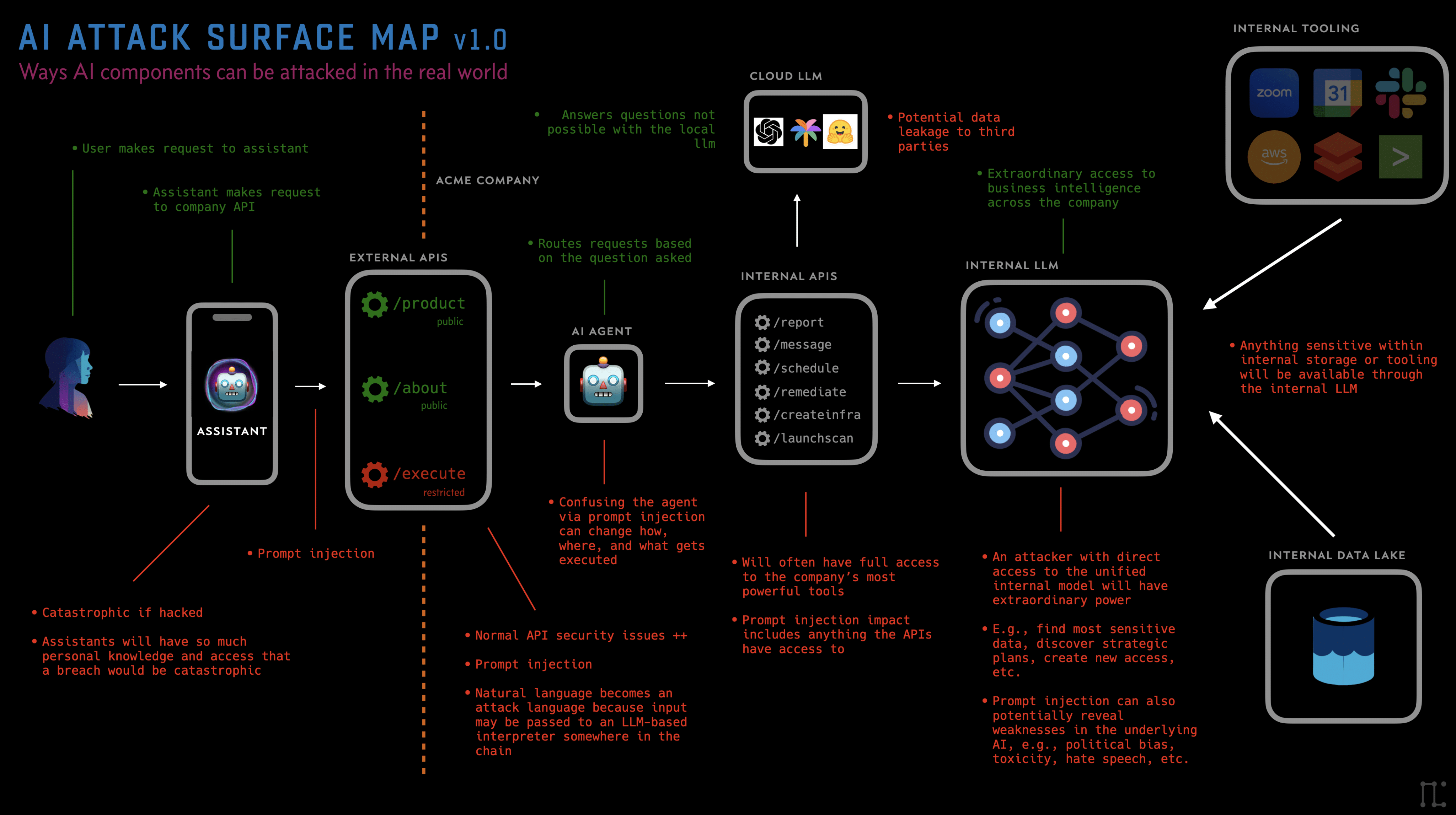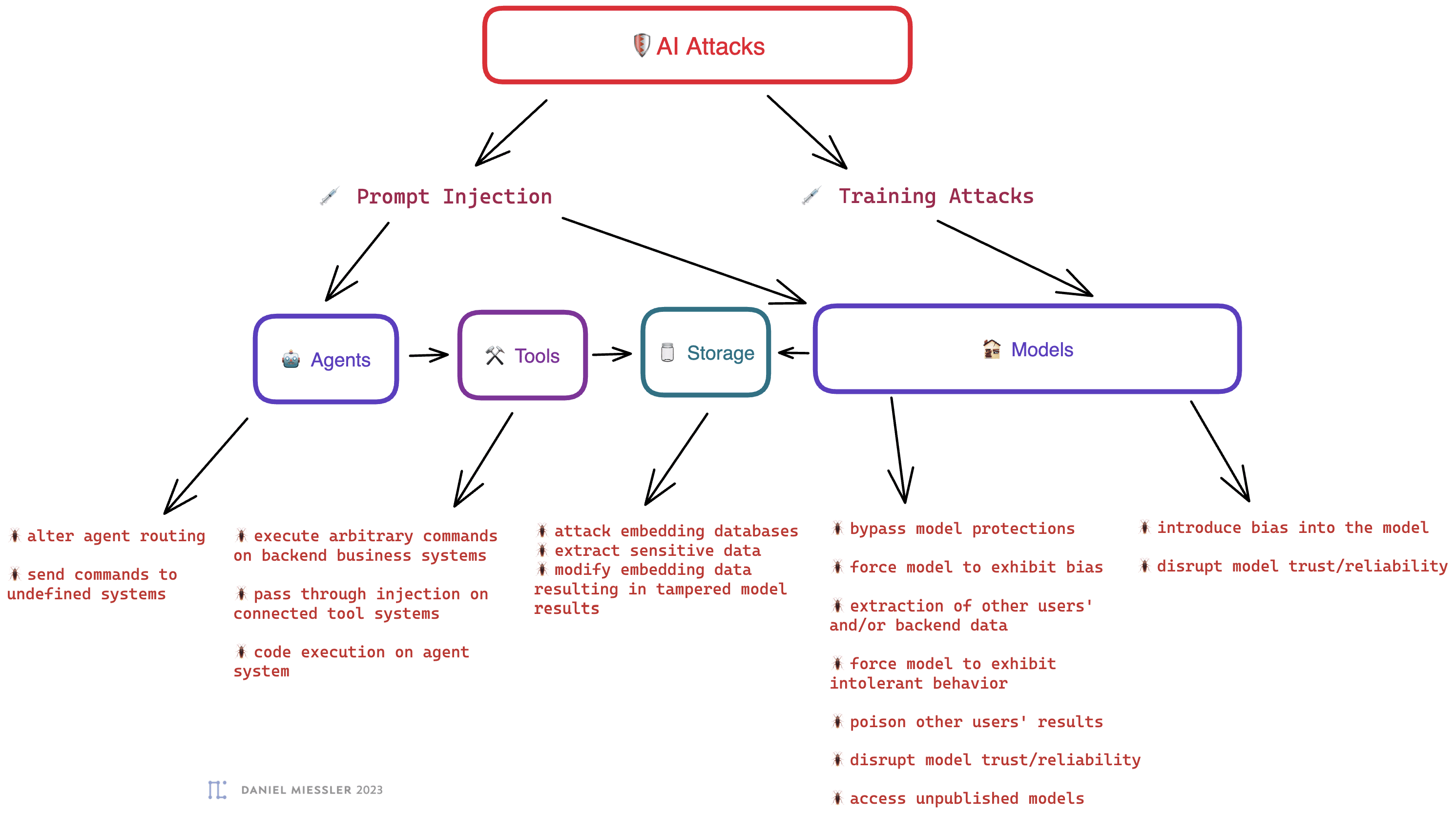Written by Laurent Dupont
Welcome
In our May edition of the TMI newsletter, we’ll get into some more technical practices of threat modeling: you’ll get ideas on how to attack AI systems; how to have your data encrypted by an AWS Service, and in what way AI such as ChatGPT and STRIDE can help you learn how to threat model. Quite enough info to keep you busy and learning for a while, so tuck in!
Enjoy the read, and spread the threat modeling message!
The TMI line-up for this month:
- The AI Attack Surface Map V1.0, written by Daniel Miessler
- AWS KMS Threat Model, by Costas Kourmpoglou
- How to use Chat GPT to learn Threat Modeling, by Rusty Newton
- Toreon blog: OWASP SAMM Threat Modeling: From Good to Great, by Sebastien Deleersnyder
- The Threat Modeling Podcast, by Adam Shostack
- An update on our upcoming training sessions
The AI Attack Surface Map v1.0
A resource for thinking about the various attack surfaces related to AI, written by Daniel Miessler
Introduction
This resource is a first thrust at a framework for thinking about how to attack AI systems.
At the time of writing, GPT-4 has only been out for a couple of months, and ChatGPT for only 6 months. So things are very early. There has been, of course, much content on attacking pre-ChatGPT AI systems, namely how to attack machine learning implementations.
It’ll take time, but we’ve never seen technology be used in real-world applications as fast as post-ChatGPT-AI.
But as of May of 2023, there has not been much content on attacking full systems built with AI as part of multiple components. This is largely due to the fact that integration technologies like Langchain only rose to prominence in the last 2 months. So it will take time for people to build out products and services using this tooling.
Natural language is the go-to language for attacking AI systems.
Once those AI-powered products and services start to appear we’re going to have an entirely new species of vulnerability to deal with. We hope with this resource to bring some clarity to that landscape.
Purpose
The purpose of this resource is to give the general public, and offensive security practitioners specifically, a way to think about the various attack surfaces within an AI system.
The goal is to have someone consume this page and its diagrams and realize that the AI attack surface includes more than just models. We want anyone interested to see that natural language is the primary means of attack for LLM-powered AI systems, and that it can be used to attack components of AI-powered systems throughout the stack.
Components
We see a few primary components for AI attack surface, which can also be seen in the graphics above. Langchain calls these Components.
HOW LANGCHAIN BREAKS THINGS DOWN
- AI Assistants
- Agents
- Tools
- Models
- Storage
Prompts are another component in Langchain but we see those as the attack path rather than a component.
AI Assistants
We’ve so far always chosen to trade privacy for functionality, and AI will be the ultimate form of this.
AI ASSISTANTS are the agents that will soon manage our lives. They will manipulate our surroundings according to our preferences, which will be nice, but in order to do that they will need extraordinary amounts of data about us. Which we will happily exchange for the functionality they provide.
AI Assistants combine knowledge and access, making them like digital souls.
Attacking people’s AI Assistants will have a high impact. For AI Assistants to be useful they must be empowered, meaning they need 1) to know massive amounts about you, including very personal and sensitive information for the highest efficacy, and 2) they need to be able to behave like you. Which means sending money, posting on social media, writing content, sending messages, etc. An attacker who gains this knowledge and access will have significant leverage over the target
Agents
I’m using Agents in the Langchain parlance, meaning an AI-powered entity that has a purpose and a set of tools with which to carry it out. Agents are a major component of our AI future, in my opinion. They’re powerful because you can give them different roles, perspectives, and purposes, and then empower them with different toolsets.
Attacking agents will allow attackers to make them do actions it wasn’t supposed to. For example, if it has access to 12 different APIs and tools, but only 3 of them are supposed to be public, it could be that prompt injection can cause it to let you use the other tools or even tools it didn’t know it had access to. Think of them like human traffic cops that may be vulnerable to confusion, DoS, or other attacks.
Tools
Continuing with the Langchain nomenclature, Tools are the, um, tools that Agents have access to do their job. For an academic research Agent, it might have a Web Search tool, a Paper Parsing tool, a Summarizer, a Plagiarism Detector, and whatever else.
Many of the attacks on AI-powered systems will come from prompt injection against Agents and Tools.
Think about prompt injection possibilities similar to Blind XSS or other injection attacks. Detonations at various layers of the stack.
The trick with tools is that they’re just pointers and pathways to existing technology. They’re onramps to functionality. They might point to a local LLM that reads the company’s documentation. Or they might send Slack messages, or emails via Google Apps. Or maybe the tool creates Jira tickets or runs vulnerability scans. The point is, once you figure out what the app does, and what kind of tools it might have access to, you can start thinking about how to abuse those pathways
Models
Attacking models is the most mature thing we have in the AI security space. Academics have been hitting machine learning implementations for years, with lots of success. The main focus for these types of attacks has been getting models to behave badly, i.e., to be less trustworthy, more toxic, more biased, more insensitive, or just downright sexist/racist.
Failing loud is bad, but failing stealthily is often much worse.
The point is to show the ways that a seemingly wise system can be tricked into behaving in ways that should not be trusted. And the results of those attacks aren’t always obvious. It’s one thing to blast a model in a way that makes it fall over, or spew unintelligible garbage or hate speech. It’s quite another to make it return almost the right answer but skewed in a subtle way to benefit the attacker.
In the model-hacking realm we on the hacker side will rely heavily on the academics for their expertise.
Storage
Finally, we have storage. Most companies that will be building using AI will want to cram as much as possible into their models, but they’ll have to use supplemental storage to do so. Storage mechanisms, such as Vector Databases, will also be ripe for attack. Not everything can be put into a model because they’re so expensive to train. And not everything will fit into a prompt either.
Every new tech revolution brings a resurgence of the same software mistakes we’ve been making for the last 25 years.
Vector Databases, for example, take semantic meaning and store it as matrices of numbers that can be fed to LLMs. This expands the power of an AI system by giving you the ability to function almost as if you had an actual custom model with that data included. In the early days of this AI movement, there are third-party companies launching every day that want to host your embeddings. But those are just regular companies that can be attacked in traditional ways, potentially leaving all that data available to attackers.
Attacks
This brings us to specific attacks. These fall within the surface areas, or components, above. This is not a complete list, but more of a category list that will have many instances underneath. But this list will illustrate the size of the field for anyone interested in attacking and defending these systems.
Methods
- Prompt Injection: Prompt Injection is where you use your knowledge of backend systems, or AI systems in general, to attempt to construct input that makes the receiving system to something unintended that benefits you. Examples: bypassing the system prompt, executing code, pivoting to other backend systems, etc.
- Training Attacks: This could technically come via prompt injection as well, but this is a class of attack where the purpose is to poison training data so that the model produces worse, broken, or somehow attacker-positive outcomes. Examples: you inject a ton of content about the best tool for doing a given task, so anyone who asks the LLM later gets pointed to your solution.
Attacks
- Agents
- alter agent routing
- send commands to undefined systems
- Tools
- execute arbitrary commands
- pass through injection on connected tool systems
- code execution on the agent system
- Storage
- attack embedding databases
- extract sensitive data
- modify embedding data resulting in tampered model results
- Models
- bypass model protections
- force model to exhibit bias
- extraction of other users and/or backend data
- force model to exhibit intolerant behavior
- poison other users’ results
- disrupt model trust/reliability
- access unpublished models
Discussion
It’s early times yet, but we’ve seen this movie before. We’re about to make the same mistakes that we made when we went from offline to the internet. And then the internet to mobile. And then mobile to the cloud. And now AI.
It’s about to be a great time for security people because there will be more garbage code created in the next 5 years than you can possibly imagine.
The difference is that AI is empowering creation like no other technology before it. And not just writing and art. Real things, like websites, databases, and entire businesses. If you thought no-code was going to be bad for security, imagine no-code powered by AI! We’re going to see a massive number of tech stacks stood up overnight that should never have been allowed to see the internet.
But yay for security. We’ll have plenty of problems to fix for the next half-decade or so while we get our bearings. We’re going to need tons of AI security automation just to keep up with all the new AI security problems.
What’s important is that we see the size and scope of the problem, and we hope this resource helps in that effort.
Summary
- AI is coming fast, and we need to know how to assess AI-based systems as they start integrating into society
- There are many components to AI beyond just the LLMs and Models
- It’s important that we think of the entire AI-powered ecosystem for a given system, and not just the LLM when we consider how to attack and defend such a system
- We especially need to think about where AI systems intersect with our standard business systems, such as at the Agent and Tool layers, as those are the systems that can take actions in the real world
Notes
- Thank you to Jason Haddix and Joseph Thacker for discussing parts of this prior to publication.
- Jason Haddix and I will be releasing a full AI Attack Methodology in the coming weeks, so stay tuned for that.
- Version 1.0 of this document is quite incomplete, but I wanted to get it out sooner rather than later due to the pace of building and the lack of understanding of the space. Future versions will be significantly more complete.
- 🤖 AIL LEVELS: This content’s AI Influence Levels are AIL0 for the writing, and AIL0 for the images. THE AIL RATING SYSTEM
Daniel Miessler is a cybersecurity leader, writer, and founder of Unsupervised Learning. He writes about security, tech, and society and has been featured in the New York Times, WSJ, and the BBC.
He also has a regular newsletter on security and tech news: https://danielmiessler.com/newsletter/.
Curated threat modeling content
AWS KMS Threat Model
What are the threats to letting an AWS service manage the encryption of your data instead of creating a Customer Managed Key? Airwalk Reply Principal Security Consultant Costas Kourmpoglou finds out and explains.
How to use Chat GPT to learn Threat Modeling
There are many available Threat Modeling tools and models. But now that we have AI, can we also use ChatGPT for some threat modeling? Rusty Newton performed a little exercise to simulate a quick threat modeling process using the STRIDE method and ChatGPT. Check out here if you can use ChatGPT to learn how to threat model.
Toreon blog: OWASP SAMM Threat Modeling: From Good to Great
written by Toreonite Sebastien Deleersnyder
In today’s digital age, the reliance on digital services and products has significantly increased. However, this increased dependency also comes with the need for trust and security. As innovation accelerates and DevOps teams work at increasing speed, integrating security and privacy into products becomes more challenging. This is where threat modeling can play a crucial role. Threat modeling is the process of identifying and managing application risks, enabling security specialists to collaborate with product teams and help them make informed security design choices. In this blog post, Sebastien explains how OWASP SAMM (Software Assurance Maturity Model) threat modeling can take security practices from “good” to “great” in implementing a robust Secure Development Lifecycle (SDL).
The Threat Modeling Podcast
Did you ever wonder where the four-question framework for threat modeling came from or wanted an in-depth explanation of each question? Look no further — @Adam is the first featured guest on the Threat Modeling Podcast.
We aim to make this a community-driven newsletter and welcome your input or feedback. If you have content or pointers for the next edition, please share them with us.
Kind regards,
Sebastien Deleersnyder
CTO, Toreon
Book a seat in our upcoming trainings
- Threat Modeling Practitioner training, hybrid online, hosted by DPI (cohort starting on 8 May 2023)
- Threat Modeling Medical Devices training, hybrid online, hosted by DPI & Medcrypt (cohort starting on 11 September 2003)
- Advanced Whiteboard Hacking a.k.a. Hands-on Threat Modeling, in-person, hosted by Black Hat USA, Las Vegas (5-8 August 2023)
We also organize in-company training for groups as of 10 participants.





